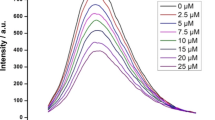Abstract
The antiglycation mechanisms of three structurally different salvianolic acids (Sals) including salvianolic acid A (Sal-A), salvianolic acid B (Sal-B) and salvianolic acid C (Sal-C) were investigated using the bovine serum albumin (BSA)-fructose model. The results showed that the three compounds could inhibit the formation of glycation products, maintain protein structural stability, mitigate the development of amyloid fibrils and scavenge radicals. Notably, Sal-A possessed the highest anti-glycated activity compared with Sal-B and Sal-C. This may be related to the fact that Sal-A contained the most molecules of caffeic acid (Sal-A, Sal-B, and Sal-C possessing two, one, and zero caffeic acid units, respectively), and caffeic acid played a leading role in the antiglycation properties relative to Danshensu. Moreover, these compounds quenched the intrinsic fluorescence intensity of BSA in a static mode, with the binding constants in the order of Sal-A > Sal-B > Sal-C. Obviously, Sal-A possessed the strongest binding affinity among these compounds, which may be one of the reasons why it exhibited the optimal antiglycation capability. Furthermore, molecular docking demonstrated that the three Sals exerted protective effects on BSA by preventing glycation modification of lysine and arginine residues. These findings would provide valuable insights into the potential application of Sals for alleviating non-enzymatic glycation of protein.
Similar content being viewed by others
Data Availability
Data are available upon reasonable request.
References
Lapolla A, Traldi P, Fedele D (2005) Importance of measuring products of non-enzymatic glycation of proteins. Clin Biochem 38:103–115. https://doi.org/10.1016/j.clinbiochem.2004.09.007
Zhou Q, Cheng K, Xiao J et al (2020) The multifunctional roles of flavonoids against the formation of advanced glycation end products (AGEs) and AGEs-induced harmful effects. Trends Food Sci Tech 103:333–347. https://doi.org/10.1016/j.tifs.2020.06.002
Wang R, Khalifa I, Du X et al (2021) Effects of anthocyanins on β-lactoglobulin glycoxidation: a study of mechanisms and structure-activity relationship. Food Funct 12:10550–10562. https://doi.org/10.1039/d1fo01665b
Haque A, Brazeau D, Amin AR (2021) Perspectives on natural compounds in chemoprevention and treatment of cancer: an update with new promising compounds. Eur J Cancer 149:165–183. https://doi.org/10.1016/j.ejca.2021.03.009
Ho JHC, Hong CY (2011) Salvianolic acids: small compounds with multiple mechanisms for cardiovascular protection. J Biomed Sci 18:30. https://doi.org/10.1186/1423-0127-18-30
Wu Q, Tang S, Zhang L et al (2020) The inhibitory effect of the catechin structure on advanced glycation end product formation in alcoholic media. Food Funct 11:5396–5408. https://doi.org/10.1039/c9fo02887k
Ni M, Song X, Pan J et al (2021) Vitexin inhibits protein glycation through structural protection, methylglyoxal trapping, and alteration of glycation site. J Agric Food Chem 69:2462–2476. https://doi.org/10.1021/acs.jafc.0c08052
Lee EY, Lee BW, Kim D et al (2011) Glycated albumin is a useful glycation index for monitoring fluctuating and poorly controlled type 2 diabetic patients. Acta Diabetol 48:167–172. https://doi.org/10.1007/s00592-010-0242-0
Li X, Zheng T, Sang S et al (2014) Quercetin inhibits advanced glycation end product formation by trapping methylglyoxal and glyoxal. J Agric Food Chem 62:12152–12158. https://doi.org/10.1021/jf504132x
Awasthi S, Saraswathi NT (2015) Silybin, a flavonolignan from milk thistle seeds, restrains the early and advanced glycation end product modification of albumin. RSC Adv 5:87660–87666. https://doi.org/10.1039/c5ra15550a
Bharmoria P, Rao KS, Trivedi TJ et al (2014) Biamphiphilic ionic liquid induced folding alterations in the structure of bovine serum albumin in aqueous medium. J Phys Chem B 118:115–124. https://doi.org/10.1021/jp4102042
Shamsi A, Ahmed A, Khan MS et al (2020) Rosmarinic acid restrains protein glycation and aggregation in human serum albumin: Multi spectroscopic and microscopic insight-possible therapeutics targeting diseases. Int J Biol Macromol 161:187–193. https://doi.org/10.1016/j.ijbiomac.2020.06.048
Qais FA, Ahmad I (2019) Mechanism of non-enzymatic antiglycation action by coumarin: a biophysical study. New J Chem 43:12823–12835. https://doi.org/10.1039/C9NJ01490J
Bouma B, Kroon-Batenburg LMJ, Wu YP et al (2003) Glycation induces formation of amyloid cross-β structure in albumin. J Biol Chem 278:41810–41819. https://doi.org/10.1074/jbc.m303925200
Zeng L, Zhang G, Liao Y et al (2016) Inhibitory mechanism of morin on α-glucosidase and its anti-glycation properties. Food Funct 7:3953–3963. https://doi.org/10.1039/c6fo00680a
Frolov A, Blüher M, Hoffmann R (2014) Glycation sites of human plasma proteins are affected to different extents by hyperglycemic conditions in type 2 diabetes mellitus. Anal Bioanal Chem 406:5755–5763. https://doi.org/10.1007/s00216-014-8018-y
Benvidi A, Rezaeinasab M, Gharaghani S et al (2018) Monitoring the protective ability of thymoquinone mixture with p-cymene against bovine serum albumin (BSA) glycation: MCR-ALS analysis based on combined spectroscopic and electrochemical methods. Int J Biol Macromol 107:2465–2474. https://doi.org/10.1016/j.ijbiomac.2017.10.135
Funding
This work was supported by the National Natural Science Foundation of China (21506152), the Open Fund of Key Laboratory of Biotechnology and Bioresources Utilization (Dalian Minzu University), Ministry of Education (KF2023006), China, the Foundation of State Key Laboratory for Chemistry and Molecular Engineering of Medicinal Resources, Guangxi Normal University (CMEMR2022-B02).
Author information
Authors and Affiliations
Contributions
Guo Feng: Investigation, Software, Validation, Writing-original draft. Yu Yan: Investigation, Formal analysis, Validation. Mengfan Wang: Investigation, Formal analysis. Zhao Gao and Yinan Zhao: Funding acquisition, Resources. Xin Peng: Conceptualization, Methodology, Supervision, Funding acquisition, Writing-review & editing.
Corresponding authors
Ethics declarations
Competing Interests
The authors declare no competing interests.
Additional information
Publisher’s Note
Springer Nature remains neutral with regard to jurisdictional claims in published maps and institutional affiliations.
Electronic Supplementary Material
Below is the link to the electronic supplementary material.
Rights and permissions
Springer Nature or its licensor (e.g. a society or other partner) holds exclusive rights to this article under a publishing agreement with the author(s) or other rightsholder(s); author self-archiving of the accepted manuscript version of this article is solely governed by the terms of such publishing agreement and applicable law.
About this article
Cite this article
Feng, G., Yan, Y., Wang, M. et al. The Inhibition Mechanisms of Three Structurally Different Salvianolic Acids on the Non-Enzymatic Glycation of Bovine Serum Albumin. Plant Foods Hum Nutr (2024). https://doi.org/10.1007/s11130-024-01167-w
Accepted:
Published:
DOI: https://doi.org/10.1007/s11130-024-01167-w




